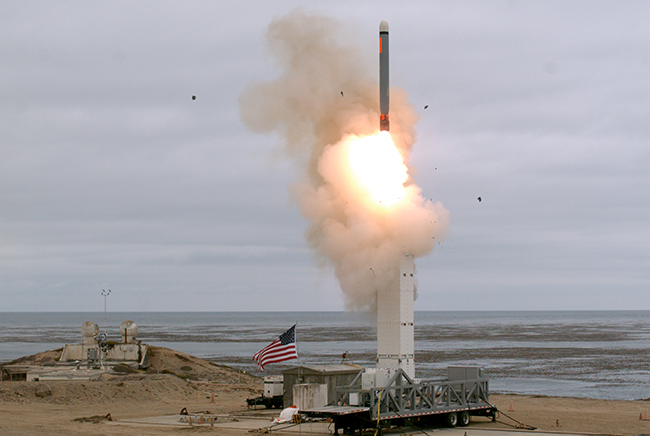
On Aug. 18, 2019, at 2:30 p.m. PDT, the Defense Department conducted a flight test of a conventionally configured ground-launched cruise missile at San Nicolas Island, Calif. DOD photo by Scott Howe.
This story was updated on Aug. 19 at 1:23 p.m. EST to include video of the test.
The Defense Department on Aug. 18 conducted a test of an intermediate-range, ground-based cruise missile, about two weeks after the withdrawal from the Intermediate-Range Nuclear Forces Treaty.
A mobile launcher fired the conventionally configured cruise missile at San Nicolas Island, Calif., and it accurately “impacted its target” more than 500 kilometers away, according to a Pentagon statement.
Video: DOD
“Data collected and lessons learned from this test will inform the Department of Defense’s development of future intermediate-range capabilities,” the statement reads.
The statement alludes to the fact that the cruise missile, while currently configured for a conventional payload, could carry a nuclear one. The Trump Administration last year announced its plans to pull out of the treaty, citing Russia’s long disregard for it and development of an intermediate range cruise missile that violates its parameters. The process for pulling out of the treaty began in February, and the US military has been developing new missiles.
“What we’ve been working on over the past several months is some research and development work for what could become a non-INF-compliant weapon system, should we get to [that] point, so we’ve postured ourselves for this possibility that we may find ourselves at a point in the near future where we’re not obligated by the INF Treaty,” Vice Adm. Dave Kriete, deputy commander of US Strategic Command, told reporters July 31. “That’s just prudent military planning.”
The treaty, which went into effect in 1987, banned all land-based cruise and ballistic missiles, either nuclear or conventional, that could strike targets between 500 and 5,500 kilometers away.
“The United States will not remain party to a treaty that is deliberately violated by Russia,” the State Department said Aug. 2 in announcing the withdrawal. “Russia’s noncompliance under the treaty jeopardizes US supreme interests as Russia’s development and fielding of a treaty-violating missile system represents a direct threat to the United States and our allies and partners.”